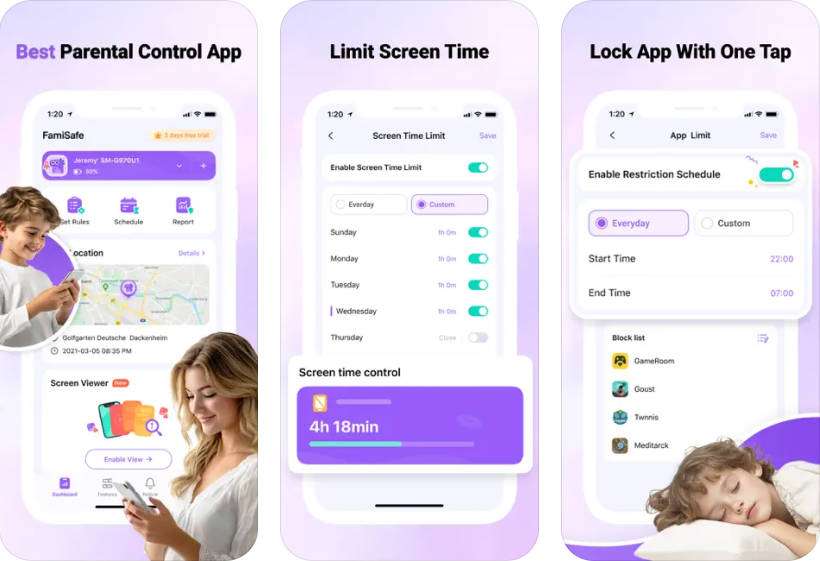Do you really know what your teens are doing on Instagram? Sexting has evolved beyond simple texting—and in 2025, Instagram has quietly become one of the most common places where suggestive messages, private images, and risky digital behavior are exchanged.
This guide explores the reality of sexting on Instagram, the growing risks it poses to teens, and why parents, educators, and digital users must stay informed. We'll also share expert tips and tools—like FamiSafe—to help you monitor and protect your child more effectively.
Table of Content
Part 1. What Is Instagram Sexting
At its core, Instagram sexting involves the exchange of sexually suggestive or explicit messages, photos, or videos through the app's private or semi-private features. This includes Direct Messages (DMs), Stories, Close Friends posts, and even profile bios or public comment threads containing flirtatious or coded language.
Unlike anonymous apps like Kik or Snapchat, sexting on Instagram often starts with public engagement—likes, comments, or follows—before moving into private conversations. This blurred line between public interaction and private intimacy makes it harder to detect risky behavior.
Below are the most common channels used for Instagram sexting:
| Sexting Channel | What It Looks Like |
| DM Conversations | Flirty or explicit private messages between users |
| Close Friends Stories | Suggestive content visible only to select followers |
| Profiles/Usernames | Handles like @hotgirl_dm_me or bios saying “Looking for fun 😉” |
| Tagged Posts & Comments | Flirty emojis, “follow me for more” captions, or comments linking to DMs |
These “sexting accounts” or “sexting usernames” often use subtle cues to invite private conversations. While some of this behavior may appear harmless, it can quickly lead to situations involving privacy invasion, emotional manipulation, or even exploitation.
For parents and educators, recognizing these signals is the first step to prevention. In the next section, we'll explore exactly how these sexting conversations unfold—and why they can be dangerous.
Part 2. How Instagram Sexting Works
N Now that we've defined the concept, let's explore how Instagram sexting typically unfolds in 2025—and why it's often more dangerous than it appears.
It usually starts small. A provocative bio or suggestive comment draws attention. A like becomes a DM, and a few flirty exchanges later, the conversation can spiral into sexting—often without either party fully realizing where it's headed.
In some cases, users don't initiate sexting themselves. Instead, they come across Instagram sexting groups or stumble upon external Instagram sexting finder sites. These platforms showcase “free Instagram sexting usernames” and invite users to connect, often redirecting to third-party sites or adult forums with little to no moderation.
- Private DM chains: Flirty conversations that quickly escalate into explicit messaging
- Story stickers & replies: Polls like “Ask me anything” used to solicit sexual content
- Private group chats: Created via Close Friends or hidden story sharing
- Close Friends sharing: Hidden story circles used for private NSFW interactions
- Third-party links: External pages promoting adult content or bot-generated sexting chats
This shift from casual interaction to sexualized messaging can happen quickly and feel deceptively private. But remember—Instagram isn't built for anonymous or secure sexting, and it lacks most safeguards found in platforms designed for safe messaging.
Parents and teens should be cautious of sexting profiles and groups that promise secrecy but may lead to exploitation, extortion, or even phishing traps.
In the next section, we'll evaluate whether Instagram is a safe place for sexting, and what red flags both teens and guardians should watch for.
Part 3. Is Instagram Sexting Safe?
Despite its polished public image, Instagram is far from a safe space for sexting—especially for teens. The platform lacks essential safety features needed for private, secure exchanges.
Instagram was not built for sexting. There are no screenshot alerts, no disappearing message timers, and minimal protections against fake profiles or unsolicited DMs. While some privacy settings exist, most users—especially minors—don't configure them properly.
- Lack of anonymity: Real names, bios, and mutual followers often reveal identity
- Content exposure: Anyone can screenshot your DMs or Stories without warning
- Fake accounts: Impersonators use sexting to lure users into dangerous conversations
- Poor moderation: Private chats are not actively scanned or filtered for explicit behavior
These factors make Instagram a high-risk platform for sexting—even for consenting adults. For teens, the lack of safeguards and ease of connecting with strangers make it an especially dangerous environment.
So, can you sext on Instagram safely? Technically yes, but practically, the risks of exposure, manipulation, or blackmail are too high.
👉 In the next section, we'll explore why teens are particularly vulnerable—and what families can do to respond.
Part 4. The Hidden Dangers of Instagram Sexting for Teens
For teens, Instagram sexting isn't just risky—it can be outright dangerous. While some minors may willingly engage in sexting, many are manipulated, coerced, or exposed to adult content through the algorithm before they're ready.
⚠️ Key Dangers of Teen Sexting on Instagram:
- Algorithm exposure: Liking or following sexual content triggers more of the same in their feed
- Grooming tactics: Predators often impersonate peers using fake profiles to initiate sexting
- Sextortion: Teens who share private images may face blackmail or humiliation
- Adult content loops: Niche hashtags like #gaysexting or #roleplay seduce teens into explicit digital environments
A teen following Instagram sexting accounts might not realize they're being targeted. The transition from casual following to risky exchanges can happen in a matter of minutes—without parents ever noticing.
👉 That's why digital safeguards are essential. In the next part, we'll explore how to protect teens using proactive conversation and smart digital tools.
Part 5. How to Protect Teens from Instagram Sexting
No digital environment is 100% safe—but parents can take meaningful steps to reduce the risk of Instagram sexting for teens. The best approach combines conversation, boundaries, and active guidance.
🧠 What Parents Can Do to Protect Teens on Instagram:
- Talk openly about what sexting is and how it can emotionally affect teens
- Adjust Instagram parental settings—limit DMs, restrict story viewers, and use “Close Friends” wisely
- Monitor who your teen follows and who follows them, especially accounts with flirtatious bios or usernames
- Set daily app usage limits to avoid overexposure to risky content
- Watch for red flags: secrecy, deleting messages, anxiety around phone use
- Create digital rules together as a family—respectful, not restrictive
👉 Want deeper insight and safety alerts without invading privacy? Let's explore the most effective tool for digital supervision next.
If you're a parent concerned about Instagram sexting, what you need is more than just a content filter—you need a comprehensive digital safety net. That's where FamiSafe stands out.
FamiSafe is not just another parental control app. It's a smart monitoring platform designed specifically to combat modern social media risks like Instagram sexting, online grooming, and exposure to harmful content. It empowers parents to stay informed without invading their teen's privacy.
Whether your child uses Instagram for messaging, stories, or DMs, FamiSafe offers real-time detection, behavior alerts, and customizable app controls—all in one intuitive dashboard.

FamiSafe Key Features:
📌 Real-Time Keyword & Emoji Detection: Get instant alerts if your teen receives or sends risky messages on Instagram—covering slang terms, sexual phrases, and even inappropriate emojis.
📵 Smart App Usage Control: Set daily usage limits for Instagram or block it entirely during school hours, sleep time, or when needed.
📍 Live Location & Geofencing: Know where your child is at all times. Set up virtual boundaries (home, school, etc.) and receive alerts when they enter or leave.
🖼️ Inappropriate Content Detection (Photos & Videos): Automatically scan saved images and media for nudity or unsafe visuals—even on platforms like Instagram or WhatsApp.
📊 Activity Reports & Behavior Insights: Track which apps your teen uses most, how often they interact on Instagram, and spot usage spikes that might indicate hidden risks.
🔐 Privacy-Respecting Monitoring: FamiSafe promotes open family communication while still offering full visibility into digital dangers—no secret surveillance, no forced controls.
🌟 Bonus: What Makes FamiSafe Stand Out?
- Works seamlessly on iOS, Android, Windows, macOS, Chromebook, Kindle Fire
- Covers over 14+ social platforms including Instagram, Snapchat, and TikTok
- Fully GDPR-compliant, with encrypted data handling
- Offers a free trial and affordable family subscription options
Conclusion
In 2025, Instagram sexting is no longer a fringe trend—it's a growing digital behavior with very real risks. What begins as a harmless DM can rapidly evolve into emotionally or even legally dangerous territory, especially for teenagers.
This article revealed how Instagram sexting happens, why it's unsafe, and what red flags to watch for. It's clear that while Instagram offers ways to connect, it also opens doors to exploitation, grooming, and unfiltered content teens shouldn't face alone.
As a parent, your role is more important than ever. But you're not alone. Tools like FamiSafe offer AI-powered keyword alerts, screen activity monitoring, and location tracking—so you can guide your teen safely through their digital world. And you can also block sexting on Instagram directly via parental control apps.
👉 Don't wait for a crisis to take action. Start protecting your child today with FamiSafe.



